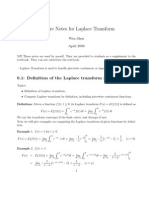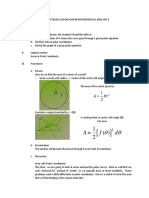Module
Uploaded by
s6wzygmxcwModule
Uploaded by
s6wzygmxcwUNIVERSITY OF NUEVA CACERES COLLEGE OF ENGINEERING AND ARCHITECTURE
Application of Laplace Transforms to ODE
I. Introduction
A useful aspect of the Laplace transform is that it changes differentiation with respect to
t into multiplication by s. When applied to a differential equation, it changes derivatives into
algebraic expressions in terms of s and the transform of the dependent variable itself.
It can therefore transform a differential equation into an algebraic equation.
II. Objectives
At the end of the week, you should be able to:
1. Apply Laplace Transform Method in solving Ordinary Differential Equations
III. Solution Steps
Solution Steps in Solving Ordinary DE using Laplace Transform Method:
1. Take the Laplace transform of all terms in the equation with respect to the independent
Variable, using the Table of Transforms.
2. Apply the initial conditions given.
3. Simplify the resulting equation.
4. Solve for L{ y } equation. Note: y = f(t); and L{ y } = F(s)
5. Take the Inverse Transform.
6. Write down the final answer in terms of the original variables given. Note: The Inverse
transform is the solution to the given differential equation.
The procedure works whether or not the differential equation is homogeneous or non-
homogeneous.
IV. Solution of Initial value Problems
Example 16.1__________________________________________________________________________
Solve the given DE using Laplace transform:
y” - 6y’ + 5y = 0 when y(0) = 1, y’(0) = -3
Solution:
L{ y” } - 6L{ y’ } + 5L{ y } = L{ 0 } applying step1; and linearity property
DIFFERENTIAL EQUATIONS/V:1.0- GINA E. DIOCOS69
UNIVERSITY OF NUEVA CACERES COLLEGE OF ENGINEERING AND ARCHITECTURE
[s2 L{ y } – sy(0) – y’(0)] -6[ sL{ y } – y(0)] +5 L{ y } = 0 applying Laplace of derivatives
[s2L{ y } – s(1) – (-3)] - 6 [ sL{ y } – 1] +5 L{ y } = 0 apply conditions given
( s2 – 6s + 5 ) L{ y } = s – 9 simplifying
L{ y } = s- 9 solving for L{ y }
2
s -6s +5
L-1 [L{ y }] = L-1 s - 9 solving for Inverse transform
s2 -6s +5
s- 9 = A + B use partial fractions to simplify
2
s -6s +5 s-1 s-5
s2 – 9 = A(s-5) + B(s-1) solving A and B
if s = 1 A=2
s=5 B = -1
L-1 [L{ y }] = y = L-1 { 2/s-1} + L-1 { -1/s-5} substituting values of A and B
y = 2 L-1 { 1/s-1} - L-1 { 1/s-5} using formula no. 5 from table
a= 1 a= 5
y = 2 ex - e5x
Answer: y = 2 ex - e5x
Example 16.2__________________________________________________________________________
Solve the following DE using Laplace transform method:
y” - 3y’ + 2y = e3x when y(0) = 1, y’(0)
Solution:
L{ y” } - 3L{ y’ } + 3L{ y } = L{ e3x } applying step 1
[s2L{ y } – sy(0) – y’(0)] -3[sL{ y } – y(0)] +5L{ y } = 1/s-3 apply Laplace of derivatives
and formula no.5
( s2 – 3s + 2) L{ y } = s – 3 + [1/s-3] using the conditions given
simplifying
( s2 – 3s + 2) L{ y } = (s – 3)2 + 1
s–3
L{ y } = s – 6s + 10
2
solving for L{ y } equation
(s2-3s +2)(s-3)
DIFFERENTIAL EQUATIONS/V:1.0- GINA E. DIOCOS70
UNIVERSITY OF NUEVA CACERES COLLEGE OF ENGINEERING AND ARCHITECTURE
L{ y } = s2 – 6s + 10 solving for L{ y } equation
(s-1)(s-2)(s-3)
L{ y } = (5/2)[1/s-1] -2 [1/s-2] + ½[1/s-3] by partial fractions
L-1 [L{ y }] = y =5/2L-1{1/s-1} - 2 L-1{1/s-2} + ½ L-1{1/s-3} Inverse transforms
a= 1 a=2 a=3 using formula no.5
y = 5/2 ex - 2 e2x + ½ e3x
Answer:
y = 5/2 ex - 2 e2x + ½ e3x
DIFFERENTIAL EQUATIONS/V:1.0- GINA E. DIOCOS71
You might also like
- Application of Laplace Transforms To ODENo ratings yetApplication of Laplace Transforms To ODE3 pages
- The Solution of Euler-Cauchy Equation Expressed byNo ratings yetThe Solution of Euler-Cauchy Equation Expressed by8 pages
- Solving Initial Value Problems Using Laplace TransformsNo ratings yetSolving Initial Value Problems Using Laplace Transforms4 pages
- Initial Value Problems and The Laplace TransformNo ratings yetInitial Value Problems and The Laplace Transform7 pages
- GOOD - Initial Value Problems and The LaplaceNo ratings yetGOOD - Initial Value Problems and The Laplace7 pages
- Chapter 7-The Laplace Transform - Part 2No ratings yetChapter 7-The Laplace Transform - Part 227 pages
- Partial Fractions: Undetermined CoefficientsNo ratings yetPartial Fractions: Undetermined Coefficients7 pages
- The Solution of Differential Equations Using Laplace TransformsNo ratings yetThe Solution of Differential Equations Using Laplace Transforms5 pages
- Math 201 Homework 6 With Solutions: WarningNo ratings yetMath 201 Homework 6 With Solutions: Warning12 pages
- Math3_Ch03_Application of Laplace Transform Spring 24-25No ratings yetMath3_Ch03_Application of Laplace Transform Spring 24-2512 pages
- AM-II - Module2 - Laplace Transform L-5No ratings yetAM-II - Module2 - Laplace Transform L-510 pages
- EENG 428 Introduction To Robotics Laboratory Experiment 4 The Use of Laplace Transformation To Solve Differential EquationsNo ratings yetEENG 428 Introduction To Robotics Laboratory Experiment 4 The Use of Laplace Transformation To Solve Differential Equations4 pages
- The Inverse Laplace Transform Partial Fractions and The First Shifting TheoremNo ratings yetThe Inverse Laplace Transform Partial Fractions and The First Shifting Theorem5 pages
- Assignment # 2 (Solution) Exercise 4.4: F T F T FNo ratings yetAssignment # 2 (Solution) Exercise 4.4: F T F T F4 pages
- MAT1002 - Module2 (Updated) For StudentsNo ratings yetMAT1002 - Module2 (Updated) For Students31 pages
- Practice Problems 10, Laplace Transforms: L (E L (T e S 5) S TNo ratings yetPractice Problems 10, Laplace Transforms: L (E L (T e S 5) S T30 pages
- 08 Inverse Laplace Transforms and Differential EquationsNo ratings yet08 Inverse Laplace Transforms and Differential Equations6 pages
- 10+2 Level Mathematics For All Exams GMAT, GRE, CAT, SAT, ACT, IIT JEE, WBJEE, ISI, CMI, RMO, INMO, KVPY Etc.From Everand10+2 Level Mathematics For All Exams GMAT, GRE, CAT, SAT, ACT, IIT JEE, WBJEE, ISI, CMI, RMO, INMO, KVPY Etc.No ratings yet
- Mathematics 1St First Order Linear Differential Equations 2Nd Second Order Linear Differential Equations Laplace Fourier Bessel MathematicsFrom EverandMathematics 1St First Order Linear Differential Equations 2Nd Second Order Linear Differential Equations Laplace Fourier Bessel MathematicsNo ratings yet
- Trigonometric Ratios to Transformations (Trigonometry) Mathematics E-Book For Public ExamsFrom EverandTrigonometric Ratios to Transformations (Trigonometry) Mathematics E-Book For Public Exams5/5 (1)
- M O D U L E S L E A R N I N G Grade 11: General MathematicsNo ratings yetM O D U L E S L E A R N I N G Grade 11: General Mathematics9 pages
- On The State-Space Modeling of Fractional SystemsNo ratings yetOn The State-Space Modeling of Fractional Systems6 pages
- Csat Aptitude Paper 2 Maths Data Interpretation High Priority Topics Sample Questions Free Studymaterial Part 2 3No ratings yetCsat Aptitude Paper 2 Maths Data Interpretation High Priority Topics Sample Questions Free Studymaterial Part 2 344 pages
- Data Science & Analytics Graduate Program Prerequisite Self-AssessmentNo ratings yetData Science & Analytics Graduate Program Prerequisite Self-Assessment3 pages
- Arjuna - Lecture Planner For Jee: Date Day Subject TopicNo ratings yetArjuna - Lecture Planner For Jee: Date Day Subject Topic9 pages
- Download full Finite Mathematics and Applied Calculus, 8e Stefan Waner ebook all chapters100% (4)Download full Finite Mathematics and Applied Calculus, 8e Stefan Waner ebook all chapters51 pages
- 06-01-How To Solve Word Problems in Algebra100% (1)06-01-How To Solve Word Problems in Algebra43 pages
- One Year Version For JEE Advanced, 2020: (For Students of Class XII / XII Pass)No ratings yetOne Year Version For JEE Advanced, 2020: (For Students of Class XII / XII Pass)6 pages
- Mathematics 8 Q1 Module 7 Finding Equation of A LineNo ratings yetMathematics 8 Q1 Module 7 Finding Equation of A Line16 pages
- Semi-Detailed Lesson Plan (Polar Coordinates)No ratings yetSemi-Detailed Lesson Plan (Polar Coordinates)8 pages
- Additional Mathematics: Paper 0606/11 Paper 11No ratings yetAdditional Mathematics: Paper 0606/11 Paper 1124 pages

























































































